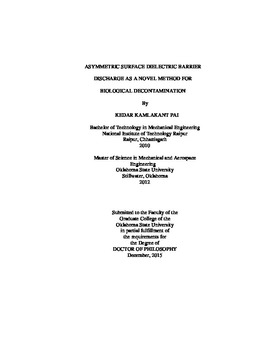| dc.contributor.advisor | Jacob, Jamey D. | |
| dc.contributor.author | Pai, Kedar Kamlakant | |
| dc.date.accessioned | 2017-02-22T22:11:37Z | |
| dc.date.available | 2017-02-22T22:11:37Z | |
| dc.date.issued | 2015-12 | |
| dc.identifier.uri | https://hdl.handle.net/11244/48919 | |
| dc.description.abstract | Scope and Method of Study: | |
| dc.description.abstract | The current study investigates the characteristics of a Surface Dielectric Barrier Discharge (SDBD) plasma actuator as a viable technology for biological decontamination, specifically asymmetric design in arrangements of electrodes. The aim of this work is to demonstrate biological decontamination and understand the plasma interaction mechanism with the cells. The effect of scaling an array of electrodes on power is analyzed and the range of voltage for optimum operation is identified. The improved effectiveness of the asymmetric SDBD is validated by a comparative analysis with a symmetric SDBD arrangement via inactivation of a 5-strain-mixture of Listeria monocytogenes. Variation in performance is analyzed using a variable distance between the actuators and the samples to demonstrate the impact of the asymmetric design. The dose dependence and plasma based effect on different cell types is analyzed using three different mammalian cells, namely, Endothelial cells (HUVECs), Neuroblastoma and Hepatocytes (HepG2). The higher tolerance of mammalian cells to plasma treatment when compared to prokaryotic cells is observed through analysis of viability, functionality and morphology. Finally, the primary mode of plasma interaction with cells was analyzed using different assays to quantify the role of each generated plasma species, such as ions, reactive oxygen/nitrogen species, etc. | |
| dc.description.abstract | Findings and Conclusions: | |
| dc.description.abstract | This study helped demonstrate specific trends in voltage requirements for scaling of linear electrodes. The asymmetric arrangement of electrodes demonstrated a 2.5 Log10 greater reduction when compared to symmetric configurations, which persisted until 3 cm away from the sample. This suggests the asymmetric design is capable of producing a larger area of plasma and pushing the species further away from the electrodes. The effective regime for plasma generation between uniform discharge and streamer formation was identified. The dose dependence on plasma was identified in different types of mammalian cells demonstrating a need for a proper matrix while treating different tissue. However, mammalian cells demonstrated higher resilience to plasma treatment with retention of functionality up to a treatment time of 4 minutes. Finally, Reactive Oxygen Species (ROS) were identified as the primary agent for plasma-cell interaction with synergistic effects from ions at close proximity to the sample in a non-aqueous medium. OH radicals (identified from Optical Emission Spectroscopy), Ozone (O3), and resulting acids such as nitric oxide form acids including nitric (HNO3) and nitrous acid (HNO2), and are hypothesized to be responsible for antimicrobial effects. | |
| dc.format | application/pdf | |
| dc.language | en_US | |
| dc.rights | Copyright is held by the author who has granted the Oklahoma State University Library the non-exclusive right to share this material in its institutional repository. Contact Digital Library Services at lib-dls@okstate.edu or 405-744-9161 for the permission policy on the use, reproduction or distribution of this material. | |
| dc.title | Asymmetric surface dielectric barrier discharge as a novel method for biological decontamination | |
| dc.contributor.committeeMember | Madihally, Sundararajan V. | |
| dc.contributor.committeeMember | Santhanakrishnan, Arvind | |
| dc.contributor.committeeMember | Delahoussaye, Ronald D. | |
| osu.filename | Pai_okstate_0664D_14407.pdf | |
| osu.accesstype | Open Access | |
| dc.type.genre | Dissertation | |
| dc.type.material | Text | |
| thesis.degree.discipline | Mechanical and Aerospace Engineering | |
| thesis.degree.grantor | Oklahoma State University | |
